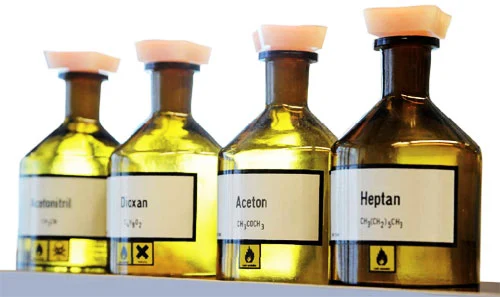The art of synthesis: The work of the analytical laboratory Witega
Sometimes, explained Dr Andreas Rolfs, we are challenged by events on the other side of the world. When, for instance, baby food laced with melamine turned up in China, an affordable analytical standard for melamine detection was developed by Witega, a company based in Adlershof and run by Rolfs as the managing director. A similar challenge proved to be the detection of the synthetic dye Sudan Red, a highly carcinogenic substance which was an additive in e.g. chilli powder.
Such sensations like melamine or Sudan Red, however, are generally the exceptions to the rule. Normally, it is about the legally prescribed detection of harmful substances in foods of animal origin, indications of abuse with approved substances or the controlled observation of thresholds, e.g. substances used as veterinary drugs like sulphonamides or penicillins. In most cases, analyses extend in addition to the detection of agent metabolites.
“Analysts must know what they’re looking for,” explained Rolfs. And this is where the analytical standards come in that are synthesised at the Witega laboratories and that facilitate or greatly simplify the detection of chemical substances in analytical laboratories. A major role is played here by compounds marked with stable isotopes: carbon, deuterium, and nitrogen. These marked compounds exhibit the same chemical properties as those without markers, but help to reduce considerably the complexity of the analysis. Accordingly, a constantly growing demand can be observed for analytical standards involving markers.
Witega is one of only a few companies worldwide to manufacture these reference materials, and its customers include state and private research laboratories, university research institutes, but above all a large number of intermediaries that are responsible for subsequent sales to customers in their own countries. Users demand a great deal from these analytical standards, above all a high purity of no less than 99%. This is ensured on the basis of thorough compound characterisation. Also, where the marked compounds are concerned, the marker must be inserted at the “right place” in the molecule if the substances are to be suitable for the analytical methods.
Set up in 1993, this Berlin company today sells over 200 analytical standards in over sixty countries. Confessing that there was enough to do, Rolfs added that their advantage lies in their fast response to the changing requirements on the market. This flexibility is maintained by the corresponding know-how, good contacts with the involved state and private institutes and the meticulous analysis of the latest specialised literature.
by Rico Bigelmann
Link: www.auftragssynthese.com
